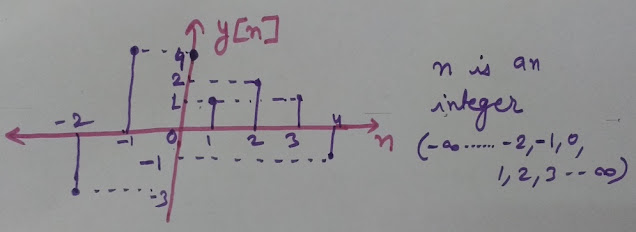What is a Signal?
Definition of Signal
A signal may be defined as a function of one or more independent variables like time, distance, position or temperature etc., that has some information about the phenomena that produced the signal.
🌓READ THIS ALSO:-
COMPARISON OF PAM, PWM, PPM MODULATION TECHNIQUES
So in other words we can say, a signal is a function of independent variables having some information.
The signals maybe motion signals, sound signals, image signals or video signals etc.
🌓READ THIS ALSO:-
COMPARISON OF PAM, PWM, PPM MODULATION TECHNIQUES
So in other words we can say, a signal is a function of independent variables having some information.
The signals maybe motion signals, sound signals, image signals or video signals etc.
Continuous Time and Discrete Time Signals Video [HD]
Signals can be classified into two types based on their characteristics in time domain-
Continuous Time Signals (C.T.)
Discrete Time Signals (D.T.)
Continuous Time Signals (C.T.)
A signal that is defined continuously with independent variable (time) is called a continuous time signal.Some physical examples of continuous time signals are- sound signals, pressure signals, temperature signals etc. Other examples are- sine wave, triangular wave etc.
The image shown below is of a continuous time signal.
 |
| Continuous Time Signal (C.T.) |
This signal has some certain value at every instant of time, in any period of time interval. Therefore it is continuous in time, so called as continuous time signal.
Discrete Time Signals (D.T.)
Discrete time signals are the signals that are defined only at discrete (distinct/separate) times.Watch Large collection of Videos on Signals and systems here
It means discrete time signals are not continuous in time.
The following image shows a discrete time signal-
 |
| Discrete Time Signal (D.T.) |
From the image given above, it is clear that value of the signal is defined only at some integer values.
Integers are- (n= ...-2, -1, 0, 1, 2, 3, 4...).
You can see in this image that value of the signal at n=1 is 1, value at n= 2 is 2, value add n= 3 is 1 and so on. But there is no value of the signal between n=1 and n=2,
So it is clear that the signal is not defined for any other value of time that is present between integer values. So we can say that, this is not continuous in time. Therefore it is called as discrete time signal (D.T.)
Example of discrete time signal - Stock market index.
Read More-
Go To HOME Page
FREQUENCY SPECTRUM OF AMPLITUDE MODULATION (WAVEFORMS AND EQUATIONS DERIVATION)
AMPLITUDE MODULATION (TIME DOMAIN EQUATIONS AND WAVEFORMS)
ADVANTAGES AND DISADVANTAGES OF DIGITAL COMMUNICATION SYSTEM
ADVANTAGES OF OPTICAL FIBER COMMUNICATION
STEP INDEX OPTICAL FIBER (MULTIMODE AND SINGLE MODE STEP INDEX FIBERS)
PULSE MODULATION TECHNIQUES (PAM, PWM, PPM, PCM)
OPTICAL FIBER: STRUCTURE AND WORKING PRINCIPLE
PULSE AMPLITUDE MODULATION (PAM)
COMPARISON OF PAM, PWM, PPM MODULATION TECHNIQUES
PULSE WIDTH MODULATION (PWM)
CONTINUOUS TIME AND DISCRETE TIME SIGNALS (C.T. AND D.T. SIGNALS)
NEED AND BENEFITS OF MODULATION
PULSE POSITION MODULATION (PPM)
OPTICAL FIBERS IN COMMUNICATION: COVERS ALL IMPORTANT POINTS
OPTICAL FIBER SOURCES (DESIRABLE PROPERTIES)
AMPLITUDE MODULATION Vs FREQUENCY MODULATION (ADVANTAGES AND DISADVANTAGES)
PULSE CODE MODULATION (PCM) [ADVANTAGES AND DISADVANTAGES]
SAMPLING THEOREM AND RECONSTRUCTION (SAMPLING AND QUANTIZATION)
SUPERPOSITION THEOREM (BASICS, SOLVED PROBLEMS, APPLICATIONS AND LIMITATIONS)
Digital Modulation Techniques (ASK, FSK, PSK, BPSK)/ Amplitude, Frequency and Phase Shift Keying
Conventional AM Vs DSB-SC Vs SSB-SC Vs VSB (Comparison of AM Systems)
Quadrature Amplitude Modulation (QAM)/ QAM Transmitter and QAM Receiver Block Diagram
Single-Mode Optical Fiber Advantages
What are Microwaves and their Applications (Uses) in various fields
Microwaves Properties and Advantages (Benefits)
Basic Structure of Bipolar Junction Transistor (BJT) - BJT Transistor - Working and Properties
Polar Plots of Transfer Functions in Control Systems (How to Draw Nyquist Plot Examples)
Generation of Binary Phase Shift Keying (BPSK Generation) - Block Diagram of Binary Phase Shift Keying (BPSK)
Low Level and High Level Modulation Block Diagram (AM Transmitter Block Diagram)
Block Diagram of CRO (Cathode Ray Oscilloscope), Components of CRO and CRT with Structure and Working
Slope Overload Distortion and Granular (Idle Noise), Quantization Noise in Delta Modulation
Frequency Translation/Frequency Mixing/Frequency Conversion/Heterodyning (Basic Concepts and Need)
Quadrature Phase Shift Keying Modulation (QPSK) Basics, Waveform and Benefits
Pulse Code Modulation (PCM) Vs Differential Pulse Code Modulation (DPCM)

Under the Uttar Pradesh State Government, the Board of High School and Intermediate Education Uttar Pradesh (UPMSP) is responsible for conducting the Intermediate Final Exam 2022. The UP Board just announced the Intermediate Final Exam Date Sheet 2022 for the Arts, Science, and Commerce streams. The UP Board 12th Class Exam will begin in the month of March. Every year, UPMSP 12th Model Paper 2022 more than 30 thousand students appear in the UP Board Intermediate Final Exam, and UPMSP has announced UP Model Paper 2022 for 12th Class Arts, Science, and Commerce streams in pdf format. Students must thoroughly practise these UP Intermediate Question Paper 2022 in order to achieve good results in the UP Board Intermediate Exam.
ReplyDelete